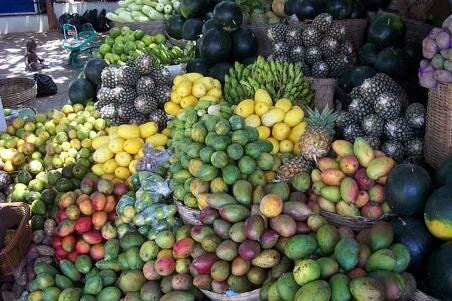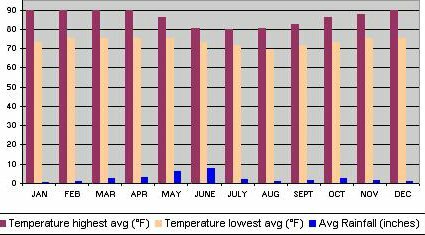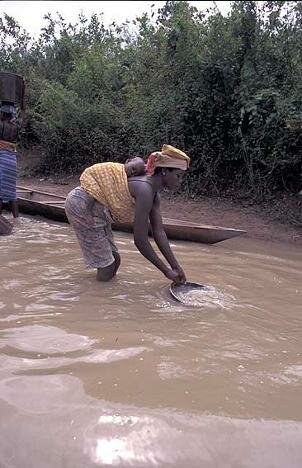About Ghana
Languages
The major languages spoken are Twi, Fante, Ga, Hausa, Dagbani, Ewe and Nzema. English is the official language of Ghana.
The Ashante are part of the Akan tribes who speak various dialects of Twi. The language is very rich in proverbs, the use of which is taken to be a sign of wisdom. Euphemisms are very common, especially about events connected with death.
People
Ghanaians come from six main ethnic groups: the Akan (Ashanti and Fanti), the Ewe, the Ga-Adangbe, the Mole-Dagbani, the Guan, and the Gurma.
 Ashanti Tribe
Ashanti Tribe
The Ashanti tribe of the Akan are the largest tribe in Ghana and one of the few matrilineal societies in West Africa. Once renown for the splendour and wealth of their rulers, they are most famous today for their craft work, particularly their hand-carved fertility dolls and their colourful kente cloth. Kente cloth is woven in bright, narrow strips with complex patterns; it's usually made from cotton and is always woven outdoors, exclusively by men.
The village is a social as well as an economic unit. Everyone participates in the major ceremonies, the most frequent of which are funeral celebrations which typically last several days. Attendance at funerals is normally expected from everyone in the village and the expenditure on funerals is a substantial part of the household budget.
The Ashanti are noted for their expertise in a variety of specialized crafts. These include weaving, wood carving, ceramics, and metallurgy. Of these crafts, only pottery-making is primarily a female activity; the others are restricted to male specialists. Even in the case of pottery-making, only men are allowed to fashion pots or pipes representing anthropomorphic or zoomorphic figures.
 Ewé
Ewé
The Ewé have over 600 deities to turn to in times of need. Many village celebrations and ceremonies take place in honour of one or more deities. They also weave kente cloth, and their more geometrical patterns contain symbolic designs handed down through the ages.
The Ewe occupy south-eastern Ghana and the southern parts of neighbouring Togo and Benin. Most Ewe were farmers who kept some livestock, and there was some craft specialization. On the coast and immediately inland, fishing was important, and local variations in economic activities permitted a great deal of trade between one community and another, carried out chiefly by women.
 Fanti Tribe
Fanti Tribe
The Fanti tribe are mainly located in the coastal areas of Ghana.
 Gaun Tribe
Gaun Tribe
The Guan are believed to have begun to migrate from the Mossi region of modern Burkina around A.D. 1000. Moving gradually through the Volta valley in a southerly direction, they created settlements along the Black Volta, throughout the Afram Plains, in the Volta Gorge, and in the Akwapim Hills before moving farther south onto the coastal plains. Some scholars postulate that the wide distribution of the Guan suggests that they were the Neolithic population of the region. Later migrations by other groups such as the Akan, Ewe, and Ga-Adangbe into Guan-settled areas would then have led to the development of Guan-speaking enclaves along the Volta and within the coastal plains.
 Ga-Adangbe Tribe
Ga-Adangbe Tribe
The Ga-Adangbe people inhabit the Accra Plains. The Adangbe are found to the east, the Ga groups, to the west of the Accra coastlands. Although both languages are derived from a common proto-Ga-Adangbe ancestral language, modern Ga and Adangbe are mutually unintelligible. The modern Adangbe include the people of Shai, La, Ningo, Kpone, Osudoku, Krobo, Gbugble, and Ada, who speak different dialects. The Ga also include the Ga-Mashie groups occupying neighborhoods in the central part of Accra, and other Gaspeakers who migrated from Akwamu, Anecho in Togo, Akwapim, and surrounding areas.
Food
Soups are the primary component in Ghanaian cuisine and are eaten with fufu (either pounded plaintain and cassava or yam), kokonte (cassava meal cooked into a paste), banku (fermented corn dough), boiled yam, rice, bread, plantain, or cassava. The most common soups are light soup, palmnut soup, and groundnut (peanut) soup.
- Avocado and Peanut Dressing
- Jolof Rice
- Herb and Nut Chicken
- West Africa curry
- Kontonmire Stew or Palaver Sauce

Kente Cloth
Perhaps the most visible (and most marketable) cultural contribution from modern Ghana is Kente cloth, which is widely recognized and valued for its colors and symbolism. Kente cloth is made by skilled Ghanaian weavers, and the major weaving centers in and around Kumasi (Bonwire is known as the home of Kente, though areas of Volta Region also lay claim to the title) are full of weavers throwing their shuttles back and forth as they make long strips of Kente. These strips can then be sewn together to form the larger wraps which are worn by some Ghanaians (chiefs especially) and are purchased by tourists in Accra and Kumasi. The colors and patterns of the Kente are carefully chosen by the weaver and the wearer. Each symbol woven into the cloth has a special meaning within Ghanaian culture.
Adinkra symbols is one of the highly valued hand-printed and hand-embroidered cloths. Its origin is traced to the Asantepeople of Ghana and the Gyaman people of Cote' d'lvoire (Ivory Coast). However, the production and use of Adinkra have come to be more associated with the Asante people than any other group of people. Around the 19th Century, the Asante people developed their unique art of adinkra printing. Adinkra clothes were made and used exclusively by the royalty and spiritual leaders for very important sacred ceremonies and rituals.

Wood carving is divided into many branches, each with its own specialists. Among the major products are wooden sculptures of outstanding artistic quality and the talking-drums (ntumpane).
The famous wooden "stools" are symbolic and ritual objects rather than items of furniture. "In Ashanti, a generation or so ago, every stool in use had its own special name which denoted the sex, or social status, or clan of the owner"
Climate
The climate is tropical but relatively mild for the latitude. Climatic differences between various parts of the country are affected by the sun's journey north or south of the equator and the corresponding position of the intertropical convergence, the boundary between the moist south-westerly winds and the dry north-easterly winds. Except in the north, there are two rainy seasons, from April to June and from September to November. In the north squalls occur in March and April, followed by occasional rain until August and September, when the rainfall reaches its peak.
Temperatures range between 21°C and 32°C (70°F - 90°F), relative humidity between 50% and 80%. Rainfall ranges from 30 to 80 inches a year. The harmattan, a dry desert wind, blows from the northeast from December to March lowering the humidity and causing hot day and cool nights in the north. The effect of this wind is felt in the south during January. In most areas, temperatures are highest in March and lowest in August after the rains. Variation between day and night temperatures is relatively small, but greater in the north, especially in January, on account of the harmattan.

Music
Ghana is often described as a land of festivals, music, and traditional dances. There is hardly any community, clan, or tribe which lacks an occasion to celebrate annually.
There are three main types of music: ethnic or traditional music, normally played during festivals and at funerals; "highlife" music, which is a blend of traditional and ‘imported’ music; and choral music, which is performed in concert halls, churches, schools and colleges.
Musical Instruments
Atsimevu is the lead drum. It is a narrow drum approximately four feet tall and its head is about eleven inches in diameter.
Axatse is the name of this rattle or idiophone. It is constructed by hollowing out a gourd or calabash. Then beads are attached to it with some string which is woven around it in a fishnet style design.
Gankogui is the name of this double bell or gong. It is constructed from iron. In Ewe music in general, and during Atsiã in particular, gankogui keeps the time.
Kaganu is a narrow drum or membranophone. It is about two feet tall, its head is about three inches in diameter and it is open at the bottom.
Kidi is a drum which is about two feet tall, its head is about nine inches in diameter and has a closed bottom. Kidi responds to calls from the lead drummer.
Sogo is the largest of the supporting drums used to play Atsiã. In some other pieces it is used as a lead drum. It is about two and a half feet tall, its head is about ten inches in diameter and it is closed at the bottom.
Accra
